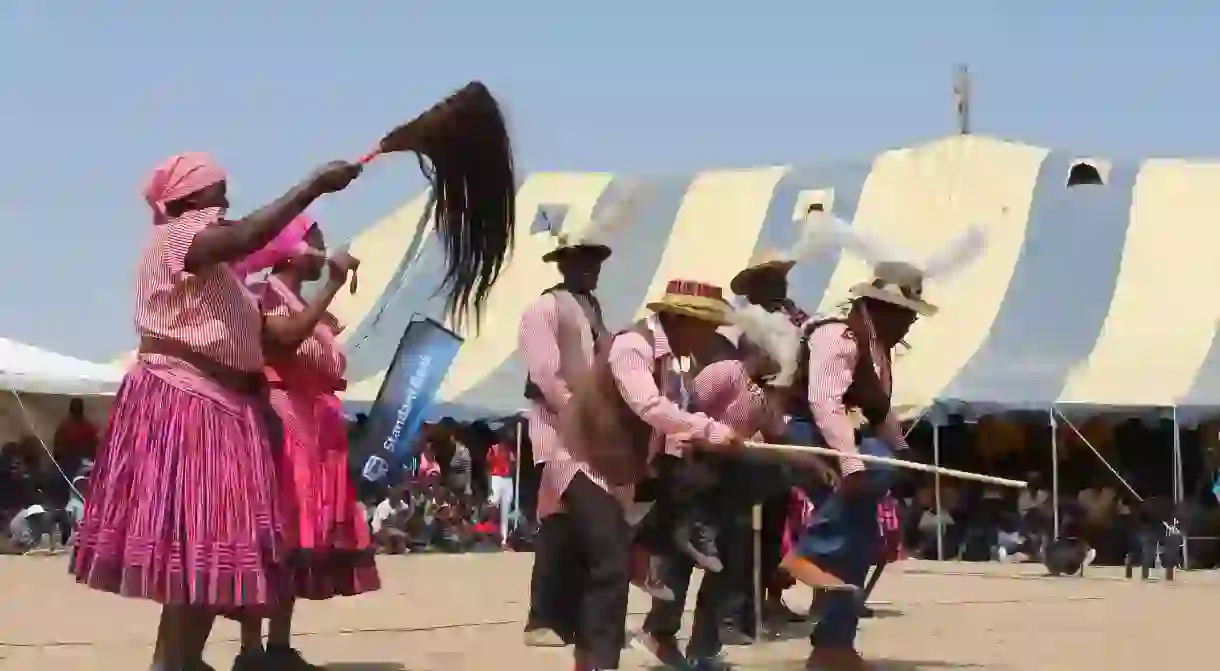A Guide to the Aawambo People of Namibia

The Aawambo, or Ovambo, people are one of Namibia’s most vibrant tribes. They have retained many aspects of their cultural practices, despite concerted efforts – especially those of Christian missionaries – to wipe out what was believed to be ‘pagan practices’.
With smaller sub-tribes including Aandonga, Aakwambi, Aangandyela, Aakwaluudhi, Aambalanhu, Aankolonkadhi and Ova-aunda, and Ova-mbadja, the biggest of the Aawambo sub-tribes are the Ovakwanyama.
History
Heavily impacted by the advent of Christianity, which was brought to Namibia in 1870 by Finnish missionaries, the Aawambo are a mostly Christian tribe who believe in God, or ‘Kalunga‘, but who have found a way to practice some of their traditional beliefs alongside The Bible’s teachings. An example of this is how wedding ceremonies are carried out or how children are welcomed into their paternal families and to the communities at large.

Homeland
This ethnic group resides mainly in northern Namibia, with some in Cunene, a southern Angolan province. Aawambo are one of the bantu tribes that migrated southwards to Namibia from the Great Lakes in East Africa, settling between the Kunene and Okavango rivers and moving futher south to what is now known as the ‘Four O’ regions of Namibia – that’s Oshana, Oshikoto, Omusati and Ohangwena. They live mainly in traditional homesteads built in a rondavel style, but nowadays modern brick houses can also be found in most homesteads.
Culture
When it comes to babies, for example, a father’s family usually gifts the baby a set containing a beaded necklace, a traditional baby carrier and a baby blanket. These gifts, to which a carry bag can also be added but isn’t compulsory, are symbolic of the father accepting the baby into his family and if this doesn’t happen, the baby is essentially not welcomed into the paternal family.

Aawambo, like many other African tribes, are a patriachal society who place a lot of power within a family and in communities on men. In pre-colonial times, their communities were run through a royal lineage where the king was the supreme leader and headmen leading each of the sub-tribes. Chieftancy is, however, assumed through a matrilineal kinship system, where hereditary chiefs are chosen only from the daughter’s children, not the son’s.
Food
There are few places in Namibia where traditional food is as widely available in a range of varieties as it is in northern parts of the country. Aawambo are proud farmers who toil their land for food sustenance. Their traditional food includes grains like sorghum and mahangu, which are used for a variety of foodstuffs ranging from porridge to traditional brews. They also grow vegetables and farm animals like cattle, goats and chicken. Fruits and berries from surrounding areas are collected for the brewing of traditional liquor such as ombike (distilled from fermented fruit) and even essential oils extracted for use in skincare products. A traditional feast in this area or among Aawambo people situated anywhere in Namibia always features a delectable buffet of mouth-watering foods that are both nutritional and filling.

Fashion
Aawambo are easily recognisable by what they wear. Their most popular clothing item, the odelela cloth, is used to make long dresses with puffy short sleeves, skirts, and even shirts for men. The cloth has been widely modernised and is also used on the traditional garments of other tribes like the Ovaherero and the Namas. When it comes to weddings, traditional ceremonies like olufuko, the odelela skirt is adorned with waist beads, shells and animal hide belts that are all worn differently depending on a woman’s age and marital status.
The correct way of wearing traditional attire is something that some are starting to forget, with elders stressing the need to not only relearn but also preserve all cultural practices. Lucina Kangete, a retired woman based in Windhoek but originally from the Okongo village in the Ohangwena, is of the opinion that culture is at risk of dying due to some people’s lack of interest in preserving it. She says, “You’ll find people telling you that they don’t do certain things in their families, but it often turns out that they are just not aware of how things are done. Many families do things differently, but the traditions are mostly uniform.”
Fortunately, various events, such as the Olufuko and Omagongo festivals, are used as opportunities to expose the young and old from this rich tribe about its cultural practices. These traditions were and still are at risk of dying out due to western influence.













